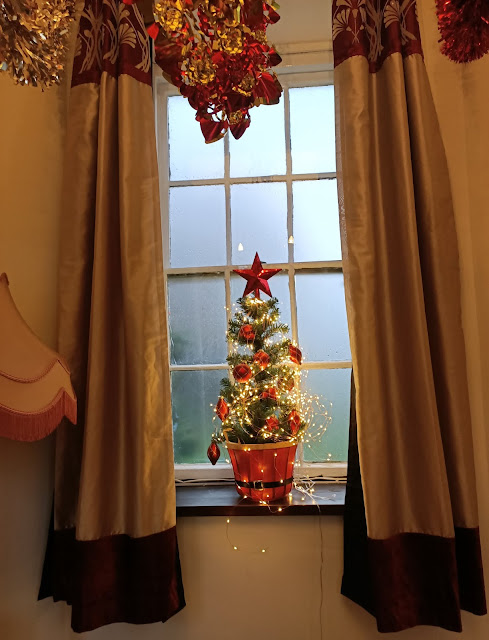Sowing seeds for next year’s flowers
 |
| Betley Court bluebells by the gazebo |
 |
| Native bluebells, under a chartreuse woodland canopy |
Opportunistic birds have moved into the burnt-out shell of Betley Court, the crows being the noisiest and most numerous of the new tenants. I have also spotted smaller birds like blue tits nesting in what were my brothers-in-laws’ bedrooms.
 |
| The path up to the barbeque area, with bluebells under Robinia pseudoacaia (false acacia) |
In the house, we’ve been into three of the partially ruined flats to remove the contents of food cupboards. It’s a preemptive move. We don’t want rodents to be attracted to the house in this warmer weather now they’re breeding. It’s given us the chance to remove soft furnishing that were rotting and holding moisture in the building too.
Elsewhere, Shane and Melvyn have touched up the paintwork on one of the apartments, and we hope to have the residents back home next month. Fingers crossed!
Old family friends, the Farmers, who are builders not farmers, have stepped in to help us re-roofed the garages. The work was delayed when the fire happened on the main house and we needed a new roofing contractor (the Farmers) to step and help us out. Of course, the shortage of building materials as a result of Lockdown also affected us, as it has everybody. It is joyous to see this job finally completed. Another ‘tick’ on the garden project ‘To Do’ list.
Down at the Visitors’ Hub, there are a few outstanding tasks. Again, we have been affected by the shortage of materials due to Lockdown, so there are kick boards, and steps and door fronts that we will have to wait for. Shane and Melvyn are ready to complete the work as soon as we can order the missing bits and bobs.
 |
| The bald earth around the Visitors' Hub building |
Around the Visitors’ Hub, the landscape is starting to heal. Bluebell and daffodil shoots have poked their way though the earth to find the light. Where Paul, the digging contractor, grubbed up tree roots from the felled mature trees, he sculpted and levelled the remaining ground. It’s left a large flattish area of smooth mud that is crying out for something to be planted. The management plan Nigel and I put together some years ago describes this area as grassland with marginal woodland edging. So, this week, I’ve set about researching native grass seed mixtures and suitable wildflower seed mixes to sow.
 |
| Native bluebells - Hyacinthoides non-scripta |
 |
| Where the new planting will happen |
The plan is to sow a gorgeous mix of hedgerow and light shade wildflowers around the edges of the area. We’ll also plant marginal woodland shrubs, like hazel and elder, to mimic natural woodland and to create a wildlife friendly understorey to the mature trees. The mix LW7P, supplied by Landlife Wildflowers includes 22 UK native wildflower species that have been specially selected to thrive in lightly shaded areas. We gone for a perennial mix to create a permanent wildflower area. The flowers will establish themselves this year and start flowering next year. Perfect for our first open days! The lovely thing about this mix is that it supports bees, butterflies and pollinators and 86% of the species are recommended by no less an authority than the Royal Horticultural Society (RHS) as ‘Perfect for Pollinators’. This time next year we will be looking at wild angelica, hedge bedstraw, buttercup, campion, mullein, mallow, garlic mustard and teasel, to name a few.
 |
| What our wildflower edging will look like, hopefully, when the LW7P mix has established |
Finding the right grass mix for this area was also a challenge, so who better to seek advice from, but Emorsgate Seeds, suppliers of wildflowers and seeds to HRH The Prince of Wales (who knows a thing or two about wildlife-friendly gardening). Around the Hub, we’re not seeking to create a tough, domestic lawn, but a more naturalistic tufted grass area, ideal for small creatures, so we've chosen the EG9 mix. It’ll be managed with occasional mowing, and will be ideal for sitting on in the summer. There are 7 species of native grass seed including the wonderfully named crested dogstail, false broom, slender creeping fescue, common bent and sweet vernal grass.
 |
| A grassed area sown with EG9 mix. What we're aiming for with our grassed area. |
There’s quite a lot of work involved to prepare the area for planting. It’ll need raking over, and the stray, half-buried stones and bricks removed. Any compacted areas need to be dug over as well. The weather forecast is a little more mixed going into May, which is a relief as trying to germinate seeds in the recent parched weather would have been a challenge too far!
All best wishes
Ladybird Su


Comments
Post a Comment